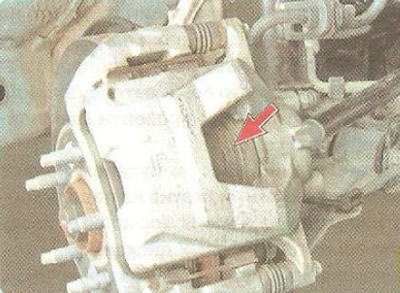Warning: Regularly check the brake fluid level in the master cylinder reservoir. The brake fluid level should be near the mark «MAX» on the body of the tank.

A drop in fluid level indicates either a leak of brake fluid from the system or excessive wear on the brake pads. If a lamp lights up in the instrument cluster, indicating a low level of brake fluid, do not rush to top it up immediately, first check the thickness of the brake pads: maybe it's time to replace the pads?
Vehicle manufacturers recommend changing all brake fluid in the system every 2 years. Some drivers ignore this advice because the fluid in the tank seems clean enough to them, and it’s completely in vain. The fact is that brake fluid is very hygroscopic - it absorbs moisture from the air, and this moisture over time not only destroys the surfaces of brake cylinders, pipelines and, as a result, leads to premature failure of brake system components, but also significantly reduces the boiling point brake fluid, The normal boiling point of DOT-4 class brake fluids is 230°C. During frequent heavy braking, disc brakes become very hot and with a high water content, the brake fluid can boil, which usually leads to brake failure.
Useful advice: In order not to expose yourself to unforeseen expenses for repairing not only the brake system, but the entire car in the future, it is better to change the fluid in the brake system in a timely manner. We recommend changing the brake fluid every 2 years.
If you have problems with the brakes, bleed the brake system (see «Bleeding the brake system». If this does not give the desired result, it is necessary to carefully check the entire braking system, as described below (see «Checking the brake system»).
Bleeding the brake system
If the brake pedal has become «soft», and with several successive clicks it becomes «harder», which means that air has entered the hydraulic brake actuator.
To remove air from the system, it is necessary to bleed the brakes. The procedure for bleeding the brakes is quite simple, but it is more convenient to carry it out with an assistant.
A detailed description of bleeding the brake system can be found in sec. 9 (see «Brake Fluid Replacement»).
Checking the brake system
1. The reason for the loss of braking efficiency may be the unsatisfactory operation of the vacuum booster. For its express check, press the brake pedal several times with the engine off to remove the vacuum in the amplifier, and then, while holding the pedal, start the engine. If the pedal drops a little after starting the engine, the vacuum booster is working.

2. If the pedal remains motionless, check the integrity and reliability of the connection of the vacuum booster hose to the fitting on the engine intake pipe...

3....and with an amplifier. Replace defective hose. If the hose is good, the vacuum booster must be replaced.
Note: The hose is connected to a non-return valve. Check the correct installation and operation of the valve (see «Checking the operation of the vacuum brake booster»). If the check valve is defective, replace the vacuum booster valve.

If braking is accompanied by a beating and pulsation of the brake pedal, you should first check the condition of the front disc brakes.

4. Having installed the car on a jack, one by one remove the front wheels and inspect the brake discs. The thickness of the brake disc must be at least 24.0 mm, the surface of the discs must be even and smooth on both sides. If the surface of the disc is covered with rust in places, which usually happens after a long parking of the car with wet brakes, try cleaning the working surface with a fine emery cloth. If this procedure does not help, you will have to give the discs for grinding or replace them with new ones.

Note: The disc surface wears unevenly. A shoulder remains on the outer circumference of the disc, so it is more correct to measure the thickness of the disc with a micrometer.

5. Check up mobility of the piston of the brake mechanism. To do this, try to move the piston with a screwdriver. If the piston cannot be moved, then it is stuck in the brake cylinder.
Warning: Jamming of the piston of the brake cylinder leads to the constant deceleration of the corresponding wheel when the pedal is released and the vehicle skids when braking.
If braking is accompanied by jerks of the car and a creak in the region of the rear wheels, if the rear of the car skids during heavy braking, check the condition of the brake mechanisms of the rear wheels.
Note: Check the thickness of the disc in the same way as you did for the front brake, the thickness of the brake disc should be at least 10mm.

Helpful Hint: The parking brake actuates the rear brakes by cables connecting the parking brake lever and the brake pad controls. Many drivers try to use the parking brake as little as possible in order to prolong it «life», and achieve the opposite result. If you do not use the parking brake, dirt and moisture stagnate in the sheaths of the cables, the cables become rusty, stop moving and break. Therefore, use the parking brake whenever necessary.
